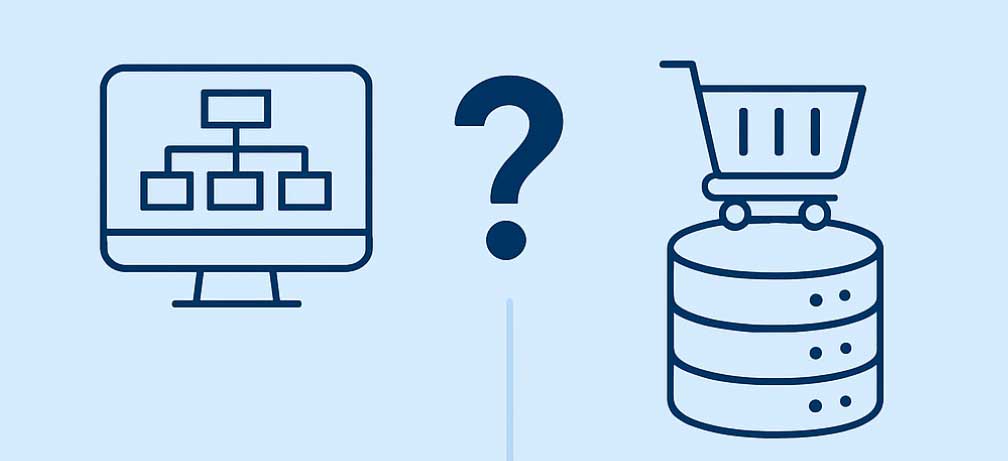Every growing eCommerce business eventually hits a wall with product information. Spreadsheets get messy, updates become a nightmare, and ensuring consistent details across your website, marketplaces, and marketing feels impossible. This leads to a crucial question: where should your “single source of truth” for product data live?
For many brands, especially those using platforms like Shopify or BigCommerce, the decision boils down to:
Should we invest in a dedicated Product Information Management (PIM) system, or can we manage effectively using our ERP or the eCommerce platform itself?
There isn’t a magic answer. The best path depends on your specific needs – how complex your products are, how many channels you sell on, how your teams work together, and your future growth plans. Let’s break down the arguments for and against adding a PIM to your tech stack.
First Off, What Exactly is a PIM System?
Think of a Product Information Management (PIM) system as your central command center for everything product-related except maybe core inventory and pricing (which often stay in an ERP). PIMs are specifically built to gather, manage, enrich, and distribute rich product content. This includes:
- Detailed descriptions (short, long, channel-specific)
- Specifications and attributes
- High-resolution images and videos
- Marketing copy and SEO details
- Translations and localized content
- Datasheets and manuals
Essentially, it centralizes all the information needed to effectively market and sell your products everywhere.
The Upside: Why Your eCommerce Store Might Need a PIM
Adding a dedicated system might seem like extra work, but the benefits can be transformative:
1. Seamless Multichannel Selling: If you’re selling on your own site (e.g., Shopify/BigCommerce) plus marketplaces like Amazon, eBay, or wholesale portals, a PIM is invaluable. It allows you to easily tailor descriptions, images, and attributes for each channel’s requirements while managing everything from one place.
2. Streamlined Team Collaboration & Enhanced Security: When multiple teams (Marketing, Merchandising, Sales, Operations) need to update or access product info, chaos can ensue without a proper system. PIMs provide workflows, version history, and clear accountability. Crucially, PIMs offer a major security advantage. You can grant specific teams access only to the product content they need (like descriptions and images) without exposing them to sensitive financial or logistical data like pricing or costs, which typically resides in your ERP. This granular control is much safer than giving broad ERP access.
3. Richer Content, Localization & Vendor Input: Need captivating long descriptions for your website, concise points for Amazon, and French translations for the Canadian market? PIMs excel at managing these variations. Furthermore, many PIMs allow you to grant controlled, limited access to third-party vendors. Imagine your professional photographer directly uploading approved product shots, or a specialized agency crafting compelling descriptions packed with fancy HTML formatting right within the PIM environment. This streamlines collaboration and elevates your data quality significantly.
4. Cleaner System Integrations: A PIM often acts as a vital hub between your ERP (holding core data like price/inventory) and your customer-facing channels (like your website). This “decoupling” lets each system do what it does best – the ERP manages logistics, the PIM manages rich content, and your eCommerce platform focuses on presentation and transactions.
The Downside: Why You Might Hold Off on a PIM
Despite the benefits, a PIM isn’t always necessary:
1. It Adds Another Layer of Complexity & Cost: Implementing a PIM means setup time, integration efforts, team training, and ongoing subscription/maintenance costs. For smaller teams with simple catalogs, the overhead might outweigh the immediate benefits.
2. Your ERP Might Be “Good Enough”: If your product data isn’t overly complex, and your ERP already handles attributes, variants, and basic descriptions reasonably well – and it integrates smoothly with your storefront – adding a PIM could be redundant.
3. Modern eCommerce Platforms Are Increasingly Capable: Platforms like Shopify and BigCommerce have significantly improved their ability to handle product data, offering custom fields (metafields), variant management, and richer content options. If your website is your primary (or only) sales channel and your needs are straightforward, your platform might suffice.
Making the Call: Should You PIM or Not?
Here’s a quick cheat sheet to guide your thinking:
Consider a PIM if:
- You manage hundreds or thousands of SKUs.
- You sell across multiple channels (website, marketplaces, wholesale, retail).
- You need different content variations per channel or region (localization).
- Multiple departments collaborate heavily on product data.
- You struggle with inconsistent, inaccurate, or incomplete product information.
- You want external vendors (photographers, copywriters) to contribute directly to product data enrichment.
- You need stricter access control to separate product content management from sensitive ERP data.
You might not need a PIM (yet) if:
- You have a small, relatively simple product catalog (e.g., under 500 SKUs).
- You primarily sell through a single eCommerce website.
- Your eCommerce platform’s built-in features (like metafields) meet your current needs.
- Your product data is clean, well-structured within your ERP, and syncs reliably.
Finding the Right Balance: The Hybrid Approach
For many scaling eCommerce businesses, the optimal solution isn’t “either/or” but a strategic combination:
- ERP: Owns the core logistical and financial data (SKU, cost, price, inventory levels).
- PIM: Owns the rich, customer-facing content (descriptions, attributes, images, videos, translations, channel-specific variations).
- eCommerce Platform: Pulls data from both the ERP and PIM via integrations to present the final product listing to the customer and handle the transaction.
This “separation of concerns” leverages the strengths of each system.
Smart Data Flow is Key
Deciding whether to implement a PIM is a strategic choice based on your current pain points and future ambitions. While it represents an investment, a PIM can drastically improve efficiency, data quality, security, and your ability to scale across multiple channels. Evaluate your product complexity, team workflows, channel strategy, and data security needs carefully to determine if now is the right time to bring a PIM into your eCommerce ecosystem.

